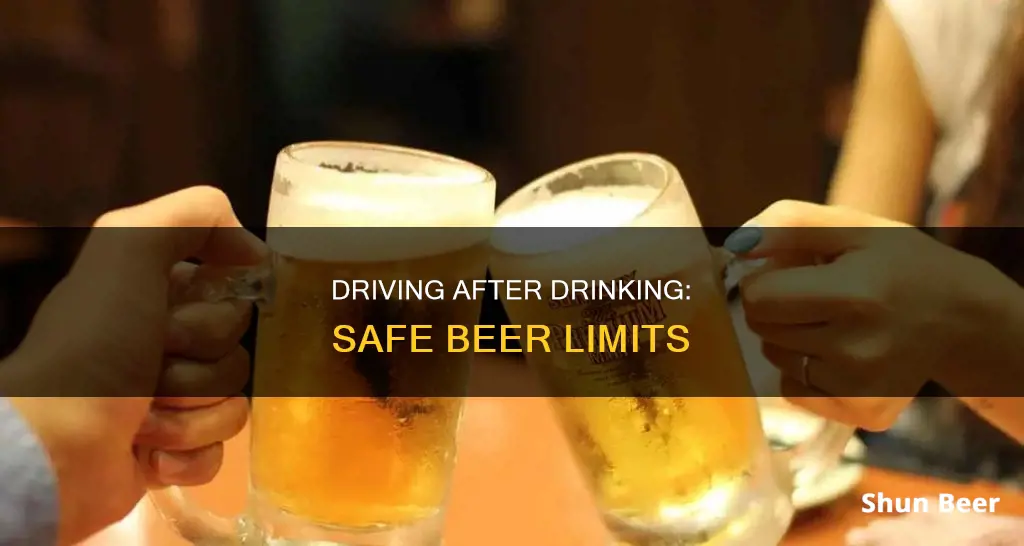
Drinking and driving is a serious offence, and it's important to know your limits. The number of drinks it takes to put someone over the legal driving limit varies depending on factors such as weight, gender, metabolism, and food intake. While there is no clear-cut answer, it is recommended that men stick to two pints of medium-strength lager or cider (4.5%) and women to one pint to stay under the drink-drive limit in England, Wales, and Northern Ireland. In Scotland, the limit is lower, with stricter regulations on blood alcohol content. It's important to note that these are just estimates, and the safest option is to avoid drinking altogether if you plan to drive.
| Characteristics | Values |
|---|---|
| Drink-drive limit in England, Wales and Northern Ireland | 80mg of alcohol per 100ml of blood |
| Drink-drive limit in England, Wales and Northern Ireland (breath) | 35 micrograms of alcohol per 100ml |
| Drink-drive limit in England, Wales and Northern Ireland (urine) | 107mg of alcohol per 100ml |
| Drink-drive limit in Scotland (blood) | 50mg of alcohol per 100ml |
| Drink-drive limit in Scotland (breath) | 22 micrograms of alcohol per 100ml |
| Drink-drive limit in Scotland (urine) | 67mg of alcohol per 100ml |
| Number of pints men can have in England, Wales and Northern Ireland and be under the drink-drive limit | 2 |
| Number of pints women can have in England, Wales and Northern Ireland and be under the drink-drive limit | 1 |
| Number of pints men can have in Scotland and be under the drink-drive limit | 1.33 |
| Number of pints women can have in Scotland and be under the drink-drive limit | 0.66 |
What You'll Learn

Men vs. women: How many pints they can have
The number of pints men and women can have varies based on several factors, including weight, age, metabolism, food intake, and medication. Men generally have a higher alcohol tolerance than women due to differences in body composition and alcohol metabolism. Here is a more detailed look at how many pints men and women can have:
For Men:
- According to guidelines, men should limit their alcohol consumption to no more than two drinks per day.
- In terms of pints, this translates to approximately two pints of medium-strength lager or cider (4.5%) while staying under the drink-drive limit.
- The time it takes to process alcohol also varies for men. For example, a man who weighs 85 kg and consumes three pints of 4% strength lager at 11 pm may need up to eight hours for the alcohol to leave their system.
For Women:
- Women are advised to consume no more than one drink per day.
- This equates to approximately one pint of medium-strength lager or cider (4.5%) while staying under the drink-drive limit.
- Women generally take longer to metabolise alcohol than men. For instance, it may take a woman around two hours to break down a pint of low-strength lager, beer, or cider (3.6%).
It is important to note that these are general guidelines, and individual tolerance may vary. Additionally, drinking and driving is never recommended, regardless of gender. The safest option is to refrain from driving if you have consumed any alcohol.
Beer and Longevity: A Pint-Sized Trade-off?
You may want to see also

Factors influencing blood alcohol content
While it is difficult to say exactly how many drinks one can have and still be okay to drive, as it differs from person to person, there are several factors that influence blood alcohol content (BAC).
Weight
An individual's weight influences their BAC as the more a person weighs, the more water their body contains. Since water dilutes alcohol, a person who weighs more will have a lower BAC than someone who weighs less after consuming the same amount of alcohol.
Number of Drinks Consumed
The more alcoholic beverages consumed, the higher one's BAC will be. The liver metabolizes alcohol at a rate of approximately one standard drink per hour. If more than one drink per hour is consumed, the liver is unable to keep up, resulting in more alcohol circulating in the bloodstream.
Age
After consuming an alcoholic beverage, an older adult will have a higher BAC than a younger adult.
Gender
Men's bodies generally have more water and less fat than women's bodies. As alcohol easily enters fat cells, women tend to have higher BAC levels than men when consuming the same amount. Additionally, women's hormones can influence the breakdown of alcohol in the body.
Food Consumption
Eating before or while drinking can impact BAC levels. Food slows down the absorption of alcohol by keeping it in the stomach for longer before it enters the small intestine, where the majority of alcohol enters the bloodstream. Fatty foods are more effective in slowing alcohol absorption than carbohydrates.
Alcohol Concentration
The higher the alcohol concentration in a drink, the faster it will be absorbed into the bloodstream. Generally, hard liquor has a higher alcohol content than beer, resulting in more rapid effects.
Carbonation
Carbonated beverages speed up the absorption of alcohol, leading to a faster rise in BAC compared to mixing alcohol with water or fruit juices.
Medications
Certain medications can amplify the effects of alcohol on the body. Examples include aspirin, tranquilizers, antidepressants, and cough medicines.
Tolerance
Long-term drinkers may develop a higher tolerance to alcohol due to their liver becoming more efficient at metabolizing it. However, while tolerance may mask the outward signs of intoxication, it does not affect BAC levels.
Fatigue, Stress, and Mood
Alcohol can have a more pronounced effect on individuals who are fatigued, stressed, or depressed. As alcohol is a depressant, it can exacerbate existing depressive symptoms.
Exploring Beer Measurements: Pints to Gallons
You may want to see also

Drink-drive limit in England, Wales, and Northern Ireland
In England, Wales, and Northern Ireland, the drink-drive limit is stricter than in other parts of the UK, such as Scotland. The limit varies depending on whether the alcohol content is measured in someone's breath, blood, or urine.
The drink-drive limit in these three countries is as follows:
- 80 milligrammes of alcohol per 100 millilitres of blood (the 'blood limit')
- 35 micrograms of alcohol per 100 millilitres of breath (the 'breath limit')
- 107 milligrammes of alcohol per 100 millilitres of urine (the 'urine limit')
It is important to note that the amount of alcohol that puts a person over the limit varies from person to person. Factors such as weight, age, sex, metabolism, the type and amount of alcohol consumed, food intake, and stress levels can influence how alcohol affects an individual.
The safest approach is to avoid alcohol entirely if you plan to drive. Drinking alcohol slows down reaction times, impairs judgment, and increases the risk of accidents. Even small amounts of alcohol can affect driving ability, and there is no reliable way to determine how many drinks will put someone over the limit. The police advise avoiding alcohol altogether if you intend to drive.
Beer Nuts vs Peanuts: What's the Difference?
You may want to see also

Drink-drive limit in Scotland
Scotland has a zero-tolerance approach to drink driving. The country's drink-drive limit was reduced from 80mg to 50mg in December 2014 and is now the same as many other European countries. The current drink-drive limit in Scotland is 50mg of alcohol in 100ml of blood, 22mcg of alcohol per 100ml of breath, and 67mg of alcohol in 100ml of urine. This limit is lower than the rest of the UK and is tough to exceed without drinking a large amount of alcohol.
It is very difficult to convert this limit into an accurate estimate of how much you can drink because everyone is different. It depends on factors including the size and strength of the drink, a person's age, gender, and weight. Alcohol affects everyone differently, and it is impossible to say exactly how many drinks this equals. The safest thing to do is to avoid alcohol altogether before driving.
The police can carry out a roadside breath test if you commit a traffic offence, is involved in an accident, or they think you may be impaired by alcohol. If you fail the roadside test or refuse to take it, the police can arrest you and take you to the station to give you two more breath tests using an advanced breathalyser. If you fail the tests at the station or refuse to take them, the police will charge you.
Drink driving is a criminal offence with serious penalties. If found guilty, you will get a minimum 12-month driving ban, up to six months in prison, a fine of up to £5,000, and the offence will stay on your license for 11 years. You might also lose your vehicle and face higher insurance costs in the future.
The only way to be sure you're not over the limit is to avoid drinking any alcohol when driving. Even small amounts of alcohol can affect your ability to drive, and there is no reliable way to drink and stay within the limit. The advice from the police is clear: avoid alcohol altogether if you plan to drive.
Dark Beer vs Stout: Unveiling the Mystery
You may want to see also

Penalties for drink-driving
Drinking and driving is a serious offence and can result in life-changing penalties. If you are found guilty of drink-driving, you could be fined, banned from driving, or even imprisoned.
Being in charge of a vehicle while above the legal limit or unfit through drink
If you are found to be in charge of a vehicle while drunk, you could face a prison sentence of up to three months and a fine of up to £2,500.
Driving or attempting to drive while above the legal limit or unfit through drink
If you are caught driving or attempting to drive while drunk, the penalties are more severe. You could be imprisoned for up to six months and banned from driving for at least one year. If you are convicted twice in ten years, the driving ban increases to three years.
Refusing to provide a specimen of breath, blood, or urine for analysis
If you refuse to provide a specimen for analysis, you could be imprisoned for up to six months and banned from driving for at least one year.
Causing death by careless driving when under the influence of drink
The penalties for causing death by careless driving while drunk are even more severe. You could be imprisoned for up to 14 years and banned from driving for at least five years. You will also have to take an extended driving test before your licence is returned.
The actual penalty you receive will be decided by the magistrates who hear your case and will depend on the severity of your offence. It's important to remember that drinking and driving is not worth the risk. The safest option is to avoid alcohol completely if you plan on driving.
Explore Beer's Nuances: Porters vs Lagers
You may want to see also
Frequently asked questions
It is recommended that men stick to 2 pints of medium-strength lager or cider (4.5%) and women to 1 pint to stay under the drink-drive limit. However, this varies from person to person and depends on factors such as weight, assigned sex at birth, medication, and how much food you've eaten.
In these countries, you are over the drink-drive limit if you have over 80mg of alcohol per 100ml of blood, 35 micrograms of alcohol per 100ml of breath, or 107mg of alcohol per 100ml of urine.
The drink-drive limit in Scotland is lower than in the rest of the UK. It is 50mg of alcohol per 100ml of blood, 22 micrograms of alcohol per 100ml of breath, or 67mg of alcohol per 100ml of urine.
It takes approximately 2 hours for a pint to leave your system, but this varies depending on factors such as the strength of the beer and individual differences in metabolism.
The punishment for driving under the influence includes a minimum 12-month driving ban, a fine of at least £2,500, and up to 6 months in prison. If convicted twice in 10 years, the driving ban increases to 3 years.







